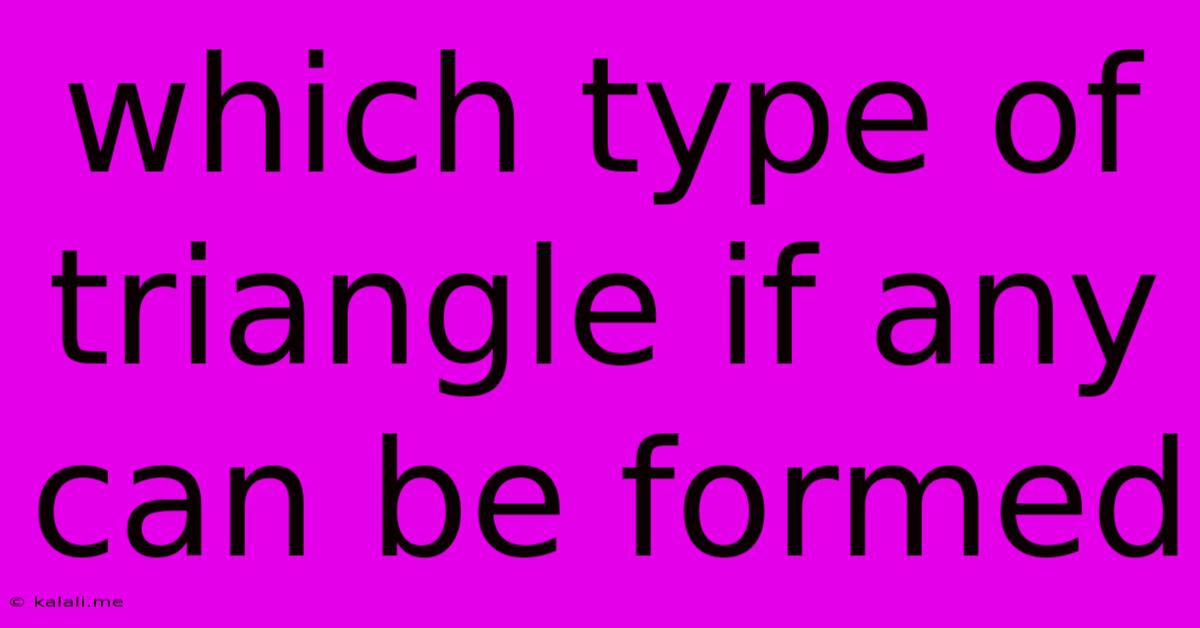Which Type Of Triangle If Any Can Be Formed
Kalali
May 09, 2025 · 3 min read

Table of Contents
Which Type of Triangle Can Be Formed? A Comprehensive Guide
Determining whether a triangle can be formed, and if so, what type of triangle it is, relies on understanding the relationships between its sides. This guide will explore the rules and conditions that define various triangle types, helping you confidently classify any given set of side lengths. We'll cover equilateral, isosceles, scalene, acute, obtuse, and right triangles.
The Triangle Inequality Theorem: The Foundation
Before classifying triangles, we must first ensure a triangle can be formed. The Triangle Inequality Theorem states that the sum of the lengths of any two sides of a triangle must be greater than the length of the third side. This is a fundamental rule. Let's say we have sides a, b, and c:
- a + b > c
- a + c > b
- b + c > a
If all three inequalities are true, a triangle can be formed. If even one is false, then no triangle is possible. This theorem forms the basis of all our further analysis.
Classifying Triangles by Side Lengths
Once you've confirmed a triangle can exist, you can classify it based on the lengths of its sides:
-
Equilateral Triangle: All three sides are equal in length (a = b = c). This also means all angles are equal (60° each).
-
Isosceles Triangle: Two sides are equal in length (a = b, or a = c, or b = c). The angles opposite the equal sides are also equal.
-
Scalene Triangle: All three sides have different lengths (a ≠ b ≠ c). All three angles are also different.
Classifying Triangles by Angles
Triangles are also classified by the measures of their angles:
-
Acute Triangle: All three angles are less than 90°.
-
Obtuse Triangle: One angle is greater than 90°.
-
Right Triangle: One angle is exactly 90°. The side opposite the right angle is called the hypotenuse, and the other two sides are called legs. The Pythagorean theorem (a² + b² = c², where c is the hypotenuse) applies to right triangles only.
Combining Classifications
It's important to understand that a triangle can be classified by both its side lengths and its angles. For example, you can have an acute isosceles triangle or a right scalene triangle. However, you cannot have an obtuse equilateral triangle (since all angles in an equilateral triangle are 60°).
Examples
Let's consider some examples:
-
Sides: 5, 5, 7: This forms an isosceles triangle (two sides are equal). To determine if it's acute, obtuse, or right, we can use the Pythagorean theorem as a comparison. 5² + 5² = 50, and 7² = 49. Since 50 > 49, this is an acute isosceles triangle.
-
Sides: 3, 4, 5: This forms a right triangle (3² + 4² = 5²). It's also a right scalene triangle because all sides are different lengths.
-
Sides: 2, 2, 5: This does not form a triangle because 2 + 2 < 5 (violating the Triangle Inequality Theorem).
Conclusion
Understanding the Triangle Inequality Theorem and the different classifications of triangles based on side lengths and angles is crucial for solving geometric problems and understanding spatial relationships. By applying these rules, you can accurately determine whether a triangle can be formed and precisely classify its type. Remember to always check the Triangle Inequality Theorem first!
Latest Posts
Latest Posts
-
What Is 144 Cm In Feet
May 09, 2025
-
In An Experiment The Variable Is Manipulated By The Experimenter
May 09, 2025
-
Cuanto Es 39 Grados Centigrados En Fahrenheit
May 09, 2025
-
What Particles Are Located In The Nucleus
May 09, 2025
-
How Many Edges Does A Rectangular Prism Has
May 09, 2025
Related Post
Thank you for visiting our website which covers about Which Type Of Triangle If Any Can Be Formed . We hope the information provided has been useful to you. Feel free to contact us if you have any questions or need further assistance. See you next time and don't miss to bookmark.